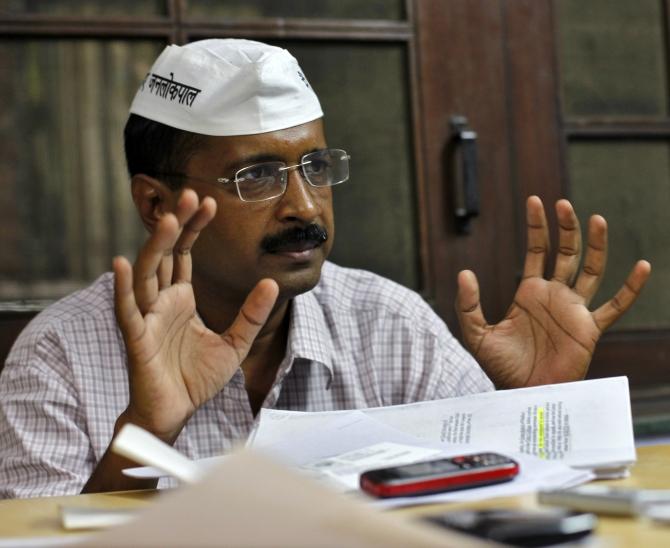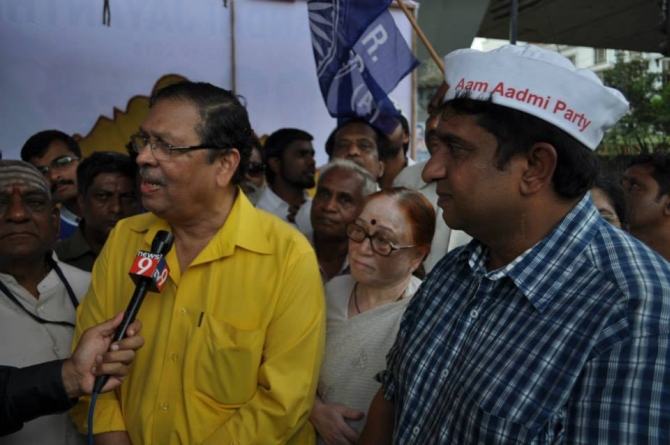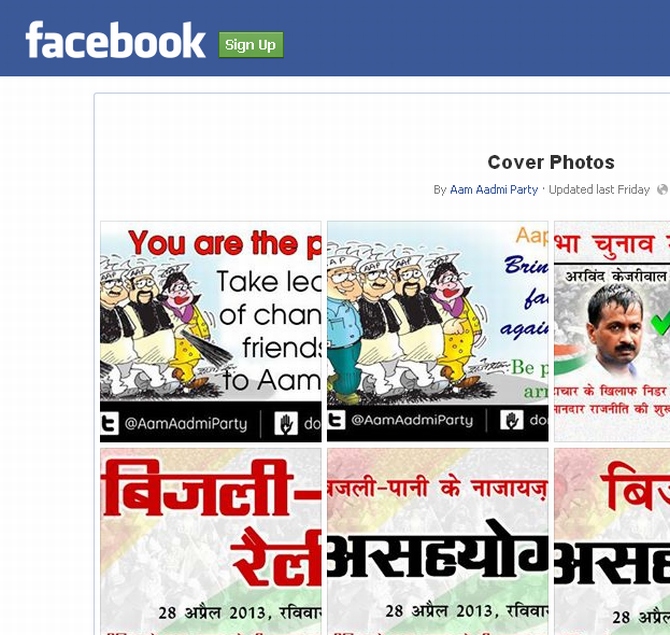
Kavita Chowdhury on the men and ideals behind the ‘people’s party’
It's 8.30 in the morning. At D-59 Pandav Nagar, east Delhi, Ratnesh Gupta, 46, a stock broker, is discussing a thick tabulated list of residents of a local apartment complex with the Aam Aadmi Party candidate from Patparganj, Maneesh Sisodia.
Twenty-five-year-old Manish Jha, a former Wipro employee, and Jyotsna, a working professional and a mother of two, are part of this brainstorming session.
What strikes one about AAP volunteers is the aam aadmi angle: Nearly 80 per cent of the 7,000-odd dedicated volunteers of the AAP are working professionals who have taken a break from their careers for party work. The party, headed by Arvind Kejriwal, is making its debut in the year-end Delhi assembly elections.
"It's now or never," says Gupta, who put his 23-year career as a stock broker on hold. "All that we've done in the past 65 years is to complain about the system. It's now time we acted." Jha has no regrets for quitting his job at Wipro in Pune. "It's all about doing something for the country. At one time, I had wanted to join the armed forces. That didn't materialise, so I am here to be with this movement, which actually works for the people."
Jyotsna had a trying time convincing her employer about the three-month leave she wanted to take. In her boss' opinion, it was a "career suicide". Now, supported financially by her husband, she's here every morning, after finishing her household chores and sending her two kids to school.
After an hour of discussions, this team would be back in the "field".
...

Taking the conventional door-to-door campaign method a step further, the team has compiled detailed lists of residents, including the number of voters in each house and contact numbers, and then, categorised them into A, B C and D, according to the feedback received.
The A category people are not just firm supporters of the AAP but also made donations. Those identified as B category are AAP sympathisers. The C and D categories are those who support other political parties.
In the next stage, AAP candidates visit only the A and B households, introducing themselves and appealing to them to turn up to vote, thereby starting a regular communication with the voter.
Says Sisodia, the AAP candidate from Patparganj and also an integral part of the party's core team: "We've had political veterans and netas laughing at us, saying despite whatever we do, ultimately it will be caste and community factors that will count. My response is that our caste is anti-corruption. And, at this moment, every resident out here is fed up with corruption; I know each of the residents individually. Do you know them like that?"
...

Quizzed on how they were managing funding, the "biggest stumbling block" for newbie parties such as AAP, Sisodia says: "How much does it take to fight an election? Not much if you keep it clean and transparent. It's the false impression given by established political parties that deters others from entering the fray."
Money in an election campaign is primarily spent on communication and on holding sabhas. While the costs of organising conventions can go up to Rs 12,000, all printed material costs, including handbills, are minimal. For instance, the SMS cost in a constituency would be around Rs 2,600 a week.
Unlike other political parties that have opposed outright the Central Information Commission ruling bringing parties under the Right to Information Act and directing parties to declare their sources of funding, the AAP has made transparency the lynchpin of its functioning.
Public donations are the mainstay. Details of donors with the amount and cheque numbers are uploaded on the AAP website, regularly updated with amounts as little as Rs 500 contribution.
Keen to contribute to the AAP initiative, an air force unit in Leh, Jammu and Kashmir, has collected Rs 1 lakh from among its personnel. Rajya Sabha member and businessman Rajeev Chandrasekhar has contributed Rs 5 lakh to the AAP.
That apart, funds are also collected through door-to-door campaign. The Patparganj constituency alone has collected Rs 2.84 lakh till date. The New Delhi constituency, where Kejriwal is contesting from, has doubled that amount.
The AAP has evinced interest even among non-resident Indians, who have been contributing through its website, with some opting for its unique "adopt a constituency" model, wherein the donor can choose to donate for a particular constituency, instead of the central funds of the party. Each of the 70 constituencies has its separate accounts volunteers who can collect up to Rs 14 lakh for each assembly seat.
Volunteers even cough up Rs 5 for the AAP topi, emblazoned with the Main Aam Aadmi hoon slogan on it, that they so proudly sport.
...

While major political parties such as the Congress and the Bharatiya Janata Party are yet to announce their candidates for Delhi polls, AAP created quite a stir when Kejriwal publicly challenged incumbent Chief Minister Sheila Dikshit and said he would contest from the New Delhi constituency.
As with the funding, the candidate selection procedure has transparency ingrained at every stage of its elaborate process. Till date, 56 candidates have been finalised for the 70 assembly seats.
First, applications are publicly called for on the website, after which applicants have to submit an exhaustive 10-page resume-cum-form with 100 signatories supporting them.
They mandatorily have to submit an affidavit promising to comply with the AAP charter--if elected, they will not sport red beacons on their cars, will not accept government accommodation, etc. A shortlist of 10 to 15 is drawn up after which these are put up on the website for public feedback and comments.
"This is an interesting process, which is completely transparent, where rivals dig up dirt against a contender, which helps us in verifying his or her true credentials. On one occasion, we found that one had a first information report lodged against him, but had not revealed that in his application," said an AAP leader privy to the selection process, who declined to be named. "The basic criteria we look for is honesty and what standing here she has in the locality."
An elaborate interview process follows before the final candidate name is selected.
The AAP has come in for criticism for giving tickets to a few former Congress and Bharatiya Janata Party politicians, a move the AAP defends, saying such candidated had publicly renounced their parties and were found to be capable contenders.
"We have kept out those who approached us claiming they are capable enough or have the money bags to fund their own elections because it's obvious that they will aim to maximise their return on investment once voted in. That's the beginning of the cycle of corruption in politics," said the AAP leader.
...

Being a fledgling party that was born as an offshoot of social activist Anna Hazare's anti-corruption movement, the AAP 'think tank' knows that the real challenge is to use "novel methods" to capture public imagination. "Nobody reads the mammoth hoardings of the Congress-led Delhi government, or the BJP," says Aneesh, an AAP volunteer.
The party has started putting up posters with its 'broom' symbol on the ubiquitous three-wheeler auto rickshaws, publicly challenging Dikshit's 15-year rule. An angry Delhi government attempted to ban auto rickshaws from sporting these posters, but soon, the BJP also adopted this publicity strategy.
Kejriwal caught the media attention as he interacted with morning walkers at the Lodhi Gardens, to campaign in the largely upmarket New Delhi constituency. Radio spots, phone messages, screening video films about the new party in neighbourhood parks are some of the means that the party is adopting to reach out to the electorate.
Also, AAP sympathisers have been requested to put up posters on their walls, while candidates take out personal house to house visits in underdeveloped resettlement and slum clusters.
Role of social media
The AAP realised the potential of the social media during the heydays of the Anna Hazare movement. "We had announced Anna's protest, which was to be held on January 30, 2011, at Ramlila Maidan in the capital, on Facebook. We were surprised to find that 55 cities across the country caught on to that message and protested together that day; such is the power of the social media," says Sisodia.
Being low on funds, the party has maximised its use of social media, with volunteers using websites such as Twitter and Facebook to put up regular updates on current developments and publicise the party's activities.
Kejriwal is active on social media and on Twitter alone, he has over 600,000 followers. Sisodia has recently started connecting with people via Google Hangout every Friday after 9 pm.
...

Poll prospects
Rejecting the speculation that the AAP in the polls is likely to play a "spoiler", party leader Kejriwal says: "Both the BJP and the Congress are accusing us of aligning with the other camp and eating into their vote share.
The truth is they are both scared of us. As per the polls conducted by an independent agency and supervised by psephologist and AAP member Yogendra Yadav, the Congress will get 25 per cent of the votes, the BJP 24 per cent and the AAP 32 per cent."
Sisodia rubbishes talks of a post-poll tie-up. "The BJP and the Congress are on one side. We are on the other. We are the alternative. We will sit in the opposition if need be but we won't cheat the people. We'll show them what a credible opposition can be and do."
Manifesto
With several firsts to its name, the party has decided to put up not just one manifesto as is generally the custom but 70 manifestos -- one for each assembly constituency. The AAP's major poll promises include political decentralisation, getting the Jan Lok Pal Bill passed and ensuring women's safety.
Teams of 20 to 25 special 'commandos' (society representatives) will be set up for this. Other promises are revamping government hospitals and schools and an audit of private power distribution companies.
The party plans to unveil the manifestos at a rally being planned on October 27 at the Ramlila maidan.
So, what has helped them make an impact despite being first-timers? "It's because of the failure of existing political parties that people see us as the credible alternative," says Kejriwal.
Party leaders, however, are aware that the greatest challenge before them is to see the popular support translate into votes on polling day.
The Anna Hazare agitation for a corruption-free polity being the 'springboard' for the AAP, the party's voice against corrupt and tainted politicians has gradually created a groundswell against corrupt netas.
It was the AAP that first held a press conference denouncing the Union Cabinet's decision to enact an ordinance to protect convicted netas from disqualification. Along with Kejriwal, the other prominent faces of the party addressed the media and stated their intent to meet President Pranab Mukherjee to urge him not to sign the Ordinance. Soon, the BJP followed. Then, the ruling Congress' vice-president Rahul Gandhi also came out against it.
Whether or not the AAP would manage to leave its mark on the polling day in the Delhi assembly election, this is for sure -- it has initiated a path for weeding criminals from the political spectrum and forced other established political parties to rethink on greater transparency in their functioning.
...